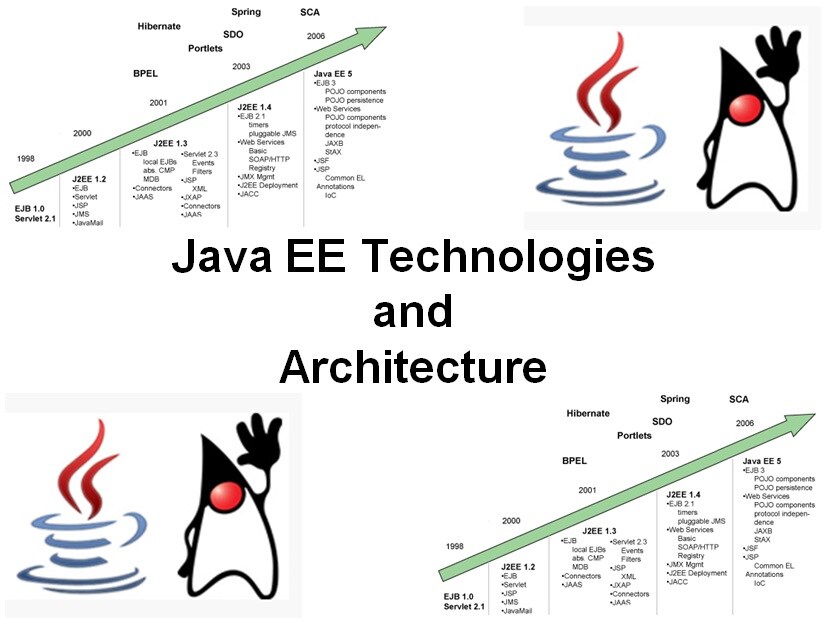-
Learning by doing
-
Trainers with practical experience
-
Classroom training
-
Detailed course material
-
Clear content description
-
Tailormade content possible
-
Training that proceeds
-
Small groups
The course Jakarta EE Technologies is intended for system architects who are involved in the deployment of Jakarta EE technology. The participants learn how to make the right choices between competing options. The course provides an overview and comparison of different modern Jakarta EE technologies and brings the knowledge of the participants on a higher level.
After an overview of the Jakarta EE platform, the most important components, Servlets and JSPs, are treated. The JSF Framework as MVC layer on the basis of Servlets and JSPs is also discussed. Furthermore, Single Page Applications are explained and the Ajax technology which is based on asynchronous requests to the server is treated.
The essence of various JavaScript frameworks such as Angular, React and Vue are also on the course program. Then we go into Java Management Extensions, JMX, which enable the monitoring and management of Java Applications and Servers.
The other important component of the Jakarta EE platform, Enterprise Beans or EJBs, will be discussed as well. And also attention is paid to the options for persistence in Java (JDBC and Persistence API).
The modules SOAP and REST Services provide an overview of the Java Web Service technology. The implementation of a Micro Service Architecture and the various frameworks that can be used for this purpose are on the course program as well.
The course ends with a discussion of the Java Messaging Service (JMS) and security in the Jakarta EE platform with policies, certificates, authentication, authorization, JSON Tokens, API keys and JAAS.
The course Jakarta EE technologies is intended for System architects and developers who want make the correct Java technology choices for their system and environment and application administrators who want to get a better understanding of various Java technologies.
General basic knowledge of software architecture and knowledge of the Java platform is required to participate in this course.
This course has a very practical nature but it is not a programming course. Central is the understanding of the operation of a technology. The theory is interspersed with short case studies. Modern IDE's such as Eclipse and NetBeans and Application Servers like JBoss and Tomcat are used. The course material is in English.
After successful completion of the course the participants receive an official certificate Jakarta EE Technologies.

Module 1 : Jakarta EE Architecture |
Module 2 : Servlets and JSP's |
Module 3 : Java Server Faces |
|
Jakarta EE Standard Jakarta EE Servers Web Components EJB Components Persistent Entities Standard Java Beans Layered Architecture Container Services Jakarta EE Web Services Deployment Descriptors Annotations Packaging in EAR Files |
What is a Servlet? Servlet Initialization HTTP Protocol Form Submission Concurrent Access What is a JSP? Translation and Request Time Scopes in Web Applications ServletContext Scope Session and Request Scope Web Application Structure Classic MVC Pattern |
JSF Feature Overview Request Processing Phases Server Side UI Components JSF Component Libraries Deployment Descriptor Faces Configuration File Facelets Page Structure Managed Beans Expression Language Facelet Default Navigation Event Handling Validators and Convertors |
Module 4 : Single Page Applications |
Module 5 : JMX |
Module 6 : Enterprise Java Beans |
|
Classic Web Application Model Ajax Web Application Model Single Page Applications Typical Ajax Interactions Creating XMLHttpRequest XMLHttpRequest Methods XMLHttpRequest Object Properties Sending the Request XMLHttpRequest readyState responseText and responseXML JavaScript Frameworks Angular, React and Vue |
Java Management Extensions JMX Goal Where is JMX used Managed Beans MBean flavors JMX Architecture Java SE Mbeans Naming MBeans MBean Server Registering Mbeans Manipulating MBeans Notification Listener |
EJB Features Session Beans Statefull and Stateless Architecture of an EJB Remote versus Local Clients Web Service Clients EJB 3.x Programming Model Life Cycle Session Beans Session Bean Pools Activation and Passivation Message Driven beans Life Cycle MDB Beans |
Module 7 : Persistence Technologies |
Module 8 : SOAP Services |
Module 9 : REST Services |
|
Direct File I/O and Serialization JDBC Overall Architecture JDBC Drivers and URL's Object Relational Mapping Persistence API in EJB 3.x Entity Classes Entity Manager Persistence Context Persistence Unit Entity Lifecycle Merging Objects Managing Identity |
What is a Web Service? RPC versus Document Style XML-Schema Java XML Mapping Java API XML Binding JAXB Binding Life Cycle JAXB API SOAP Messages Web Service Description Language JAX-WS Service Side Programming Model Client Side Programming Model |
What is REST? Standard HTTP Methods ID and Links Reference Implementation JAX-RS Addressing Path Parameters Content Negotation Multiple Representations Stateless Communications Container Item Pattern Map, Key, Value Pattern |
Module 10 : Micro Services |
Module 11 : Java Messaging Service |
Module 12 : Java Security |
|
What are Microservices? Creating HTTP MicroServices Consuming HTTP MicroServices MicroService Frameworks Spring BOOT Automatic Configuration Application Packaging DropWizard MicroServices Reactive Microservices From Callbacks to Observables Message Based Microservices |
What is JMS? Messaging Characteristics JMS API Publish and Subscribe Point tot Point JMS Architectural Components Message Types Creating and Receiving Messages Message Driven Beans MessageListeners onMessage method |
Authentication and Authorization JAAS Declarative Security Programmatic security Form Based Authentication Basic and Digest Authentication Secure Sockets Layer Encryption Types REST Service Security JSON Web Tokens API Keys |
